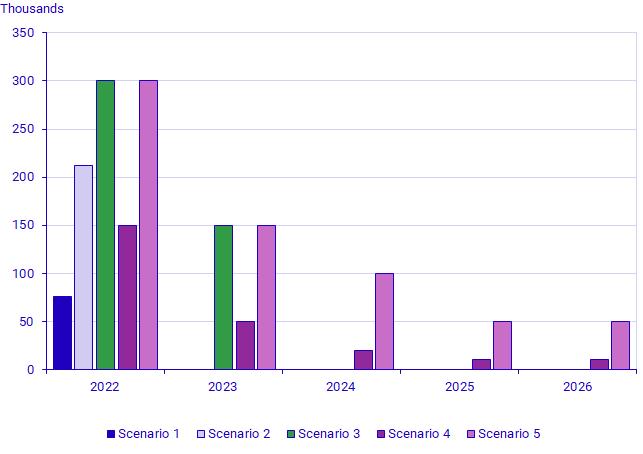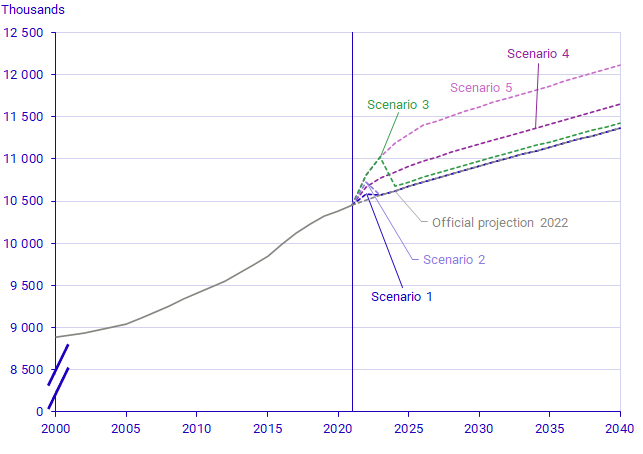The future population of Sweden 2022–2070
The invasion of Ukraine adds greater uncertainty to the population forecast
Statistical news from Statistics Sweden 2022-04-13 8.00
The population is estimated to increase by almost 900,000 inhabitants by the year 2040 and stand at 11.4 million persons. Future population trends contain a degree of uncertainty however, especially related to the size of flows of asylum seekers from Ukraine. Applying different scenarios for this immigration, the population of Sweden is estimated between 11.4 and 12.1 million by 2040.
Statistics Sweden publishes a projection of Sweden’s population every year. The presentation is broken down by age, sex and native born/foreign born persons for each year in the period 2022–2070. Population projections are an important foundation for planning in areas such as government activities. Furthermore, these statistics are used as a basis for other statistics at Statistics Sweden that describe the future in Sweden. Results and assumptions are presented in the Demographic Reports series and on Statistics Sweden’s statistical database.
Statistics Sweden’s projection is a projection of the population of registered residents. Immigrants from Ukraine who obtain a residence permit in Sweden through the Temporary Protection Directive do not become registered residents and are thus not included in the projection’s main scenario. The projection has therefore been supplemented with five different scenarios of future immigration, in which those who receive a residence permit according to the directive are also included in the calculations. All calculations were made during the period 14–18 March.
Increasing proportion of older people and the foreign-born in the population
Since 2000, Sweden's population has increased from 8.9 to just under 10.5 million people. This corresponds to an average increase of almost 1 percent per year. Over the next 10 years, the population is expected to continue to increase, but at a slower pace. By 2040, the population is estimated to increase by just over 900,000 people and to be close to 11.4 million. This corresponds to an average increase of 0.5 percent per year.
The projection assumes a continued increase in life expectancy and that immigration will be greater than emigration. The number of children born per woman is assumed to decrease in the next few years. In the long-term, fertility rates are expected to increase and reach a level higher than that seen in 2021. The annual number of births is estimated to be greater than the annual number of deaths during the entire projection period, i.e., until 2070.
An increasing life expectancy leads to an older population. Twenty percent of the population in 2021 was 65 years or over. This is proportion is estimated at 23 in 2040 and 26 percent in 2070.
A greater number of immigrants than emigrants is project to lead to an increase in the proportion foreign born. Twenty percent of the population in 2021 was born abroad. This proportion is estimated at 23 in 2040 and 24 percent in 2070.
Different scenarios describe the development in the short and long term
Forecasting future immigration is always associated with considerable uncertainty and now perhaps more difficult than ever due to the conflict in Ukraine. It is uncertain how many may apply for protection in Sweden and obtain a residence permit under the Temporary Protection Directive. It is also very uncertain how long those persons may need protection, and what happens when the directive expires. In five scenarios, assumptions are made with different levels of asylum-related immigration from Ukraine and possibly from neighbouring countries. The scenarios also assume different durations of the conflict, which may have an impact on how many immigrants remain in Sweden in the longer term. More on the different scenarios can be found in the section Definitions and explanations below. The different scenarios are numbered here from 1 to 5, but none of the five scenarios are more likely than the other.

In the first two scenarios, immigration will only be affected in 2022. At the end of 2022, the population is estimated at 10.6 million according to scenario 1 and at 10.7 million in scenario 2. In the third scenario, the population will increase to 11 million by 2023, but will decrease in 2024 to thereafter be slightly higher than the level seen in the official projection. In 2040, the population will be just over 11.4 million according to scenario 3, at just 66,000 more persons than according to the official projection.
Scenarios 4 and 5 have a clear impact on the population even in the longer term. In scenario 4, the population will increase to 11.6 million in 2040, 280,000 more than in the official projection. In scenario 5, the population will increase to 12.1 million in 2040. According to this scenario, an increase of almost 1.7 million people is estimated by 2040, or 750,000 more compared to the official projection. In both scenario 4 and 5, increased immigration is assumed during the years 2022–2026 and it is during these years that the difference compared to the official projection increases the most. The population is also affected in the longer term by the birth rates of those immigrants.

Definitions and explanations
In the short term, this projection can be regarded as a population forecast. In the long term, the projection should be regarded as precisely a projection of the population in the case that current behaviour and trends continue in the future. Furthermore, an assumption is made that regulations that apply today will continue to apply throughout the projection period. Already in the short term, changes in society may mean that projection conditions will change.
Temporary Protection Directive
On the 24th of February, Russia invaded Ukraine and on the 4th of March the European Union activated the Temporary Protection Directive (Council Directive 2001/55/EC), which grants persons from Ukraine the right to temporary residence permits in the EU. According to the Swedish Migration Agency, the permits issued in Sweden though this directive are initially valid until the 4th of March of 2023. The permits should be extended by six months at a time if the need for protection remains. This means that persons that come to Sweden via this directive should not be registered as resident in Sweden, as one is generally required to have a residence permit that is valid for 12 months or longer to be registered in the Swedish Population Register.
The Swedish Migration Agency reports current statistics on how many people applied for protection according to the Temporary Protection Directive. In a press release published on the 11th of March, the agency presented forecast scenarios of how many people may apply for protection in Sweden during the period between March and June of this year. In their main scenario, the number is estimated at 76,000 people and in their higher scenario at 212,000 people.
The five scenarios
- Scenario 1:
Immigration corresponding to the Swedish Migration Agency's main scenario in 2022, i.e., 76,000 people. The Temporary Protection Directive expires in 2023 and those immigrants and their children emigrates from Sweden that year. - Scenario 2:
Immigration corresponding to the Swedish Migration Agency's higher scenario in 2022, i.e., 212,000 people. The Temporary Protection Directive expires in 2023 and those immigrants and their children emigrates from Sweden that year. - Scenario 3:
Immigration in this scenario corresponds to the Swedish Migration Agency's higher scenario in the short term, but with continued immigration in the autumn of 2022 and during 2023 for a total of 450,000 people. The Refugee Directive expires in 2024 and most will leave Sweden. A small proportion of people are estimated to receive work-related residence permits and stay in Sweden. - Scenario 4:
Increased immigration during the period 2022–2026, a total of 240,000 people. This scenario may correspond to a situation with a more long-term need for protection is needed, longer than the three-year period that the Temporary Protection Directive can last. In this scenario, it is estimated that the persons seeking protection under the directive will be granted residence permits as refugees after the directive expires. In this scenario, an increased number of refugees from other countries in the area may also apply for and obtain asylum in Sweden. - Scenario 5:
Similar to scenario 4, with immigration during the period 2022–2026, but at a higher level, at a total of 650,000 people.
Publication
A more detailed report of this survey is published in (only in Swedish):
The future population of Sweden 2022–2070
Scenaries of asylum immigration and impact on the population
Next publishing will be
Regional population projections for counties and municipalities will be published on the 25th of May.
Statistical Database
More information is available in the Statistical Database
Feel free to use the facts from this statistical news but remember to state Source: Statistics Sweden.
